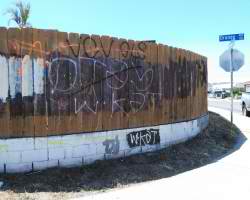The city of Chula Vista eliminated staff positions for its graffiti abatement program four years ago because of budget cuts.
Norma Rodriguez, Chula Vista’s graffiti abatement coordinator, estimated the program cost the city about $180,000.
Now the Buff-A-Block program is made up of volunteers like Southwest Chula Vista Civic Association President Tino Martinez.
Martinez tackled the graffiti issue in his Southwest Chula Vista neighborhood about two months ago, forming his own removal team, Adopt-A-Block, consisting of his wife and occasionally his nephew.
Through Buff-A-Block, Martinez is provided with paint, rollers and other necessary material to cover up graffiti on businesses and homes. Martinez said he recently found Home Depot as a corporate donor and they will supply his association with $100 a month for painting supplies.
Martinez doesn’t cover graffiti without a resident’s or business owner’s permission and only paints in highly visible areas. For safety reasons he doesn’t paint graffiti in aqueducts or near trolley tracks.
The reason Martinez said he is fighting the spread of graffiti is to help change southwest Chula Vista’s image, a community he’s been a part of for 38 years.
“So that people who visit this place and people who live in this place don’t think of the southwest as ghetto anymore,” he said. “We need to bring up the standards and that’s what I’m trying to do.”
Martinez initially sought the city’s help in combating what he called a “ tremendous graffiti problem,” but after consistently being told the city lacked resources he decided to take matters into his own hands.
“It came to a point where I realized I still have to wake up and see this (graffiti). I still have to drive around and see this,” he said. “So I had to take action and at this point I’ve realized not only myself but a community has to take pride in our own community and do these certain types of things when our city can’t,”
Martinez said southwest Chula Vista is bombarded with graffiti and it experiences more graffiti than the neighborhoods on the east side of the city.
Rodriguez said it only looks like there is more graffiti in the city because there isn’t anyone on staff to clean it up.
“It’s not that we have more than before,” she said. “It’s just that since we don’t have a staff to eradicate graffiti it looks like we have more.”
Martinez said he usually averages 20 minutes to cover up graffiti, with larger walls taking him upwards of 40 minutes.
He’s also used about 10 gallons of paint so far.
He said he always takes before and after photos of a tagged location and uploads them to a web-based system called Graffiti Tracker. The system helps identify, track, prosecute and seek restitution from graffiti vandals.
Martinez said there is a thin line between art and graffiti. Martinez said he combats graffiti that consists of letters and numbers from local tagging crews.
“I never seen art,” he said. “What I cover up here is graffiti.”















